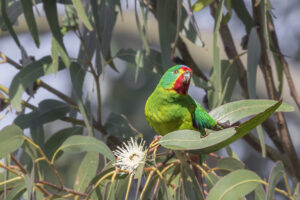Introducing Eucalyptus ovata – Part 2
Importance
Black gums are the unsung hero of the swift parrot. Tasmanian blue gum gets all the attention, but the black gum’s flowers are also an important food source for swift parrots, providing food during the early breeding season and in places where there is no flowering blue gum. As swifties depend on blue and black gum flowers, without flowering black gums, the situation would be bleak for swift parrots. It is unlikely that swift parrots could survive long without this essential food source. Black gum forest communities that are co-dominated by white gum (Eucalyptus viminalis) also represent a critical feeding resource to the forty-spotted pardalote.
Black gum forest and woodland communities are important for many other species, including Tasmanian endemic and threatened species. Black gum forests have recently been identified as important habitat for Eastern Bettongs (Bettongia gaimardi) and Long-nosed Potoroos (Potoroos tridactylous). Eastern, or Tasmanian Bettongs are extinct on mainland Australia, and the Long-nosed Potoroo is decreasing on mainland Australia. Smaller patches of black gum communities in agricultural areas are important for providing shelter for shy, transitory animals that don’t like big open spaces. These patches can act like islands and make foraging and migrations much easier and safer for a range of species like Tasmanian devils, quolls, bandicoots, birds of prey, invertebrates, frogs and reptiles.
Protection
It’s not just about having mature black gums. A healthy black gum forest and woodland needs a good understory of shrubs, native grasses and smaller trees. It needs protection from weeds and from introduced grazing animals like livestock and deer. It needs a healthy subterranean environment of plant roots to keep the water table and soils stable and less vulnerable to erosion. All of this helps protects mature black gums by keeping the plants healthy and improving resilience to herbivorous insects, birds, and mammals.
If we can conserve black gum forests, that provide specific resources for threatened species (food, water, shelter) especially for specialist feeders like the swift parrot and forty-spotted pardalote, we can provide much more habitat for these animals to fulfill their role in the ecosystem, breed and raise young, and shelter from introduced predators such as cats, sugar gliders and rats.
Continuing to conserve what black gum forest patches we have left is a great start, but it only serves to maintain the total habitat area and threatened species that inhabit it. If we can increase the size and number of black gum forest and woodland areas in Tasmania, we can significantly improve black gum forest health and productivity. The more healthy black gum communities we create and protect, the more habitat, food and shelter will be available to the endangered species that depend on it.
Black Gum Conservation Group & How to Help
The Black Gum Conservation Group (BGCG) is a newly formed not-for-profit group working hard to protect this vegetation community. The BGCG’s primary objective is to increase the area of black gum forest and woodland in Tasmania as well as protect existing forests. The BGCG aims to re-establish black gum forest and woodland in suitable areas through revegetation projects on public and private land. The BGCG is entirely volunteer based, therefore the more hands on deck, the faster we can get more black gum into the ground, for the sake of our unique Tasmanian forests and the threatened species that rely on them. To get involved, visit the BGCG webpage here and join as a member to receive updates on future volunteer opportunities.
Written by Jason Graham, B Environment & Wilderness Studies
